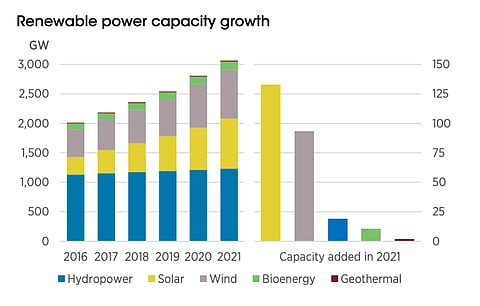

The International Renewable Energy Agency (IRENA) counts the world to have a total renewable energy generation capacity of 3,064 GW at the end of 2021. The largest share comes from hydropower, which is expected to be taken over soon by solar that added 133 GW to 257 GW new capacity last year.
On cumulative basis, it is an annual growth of 9.1%; for solar energy it was an increase of 19%; while hydropower generation last year increased by 19 GW or only 2% YoY, as per IRENA's latest Renewable Capacity Statistics 2022 report. After solar, the largest 2021 renewable energy generation capacity came from wind with 93 GW.
In cumulative terms, solar with its 849 GW has officially taken over wind energy capacity of 825 GW. For solar, maximum generation capacity was added in Asia in 2021 with 76 GW out of which China accounted for the largest share. Apart from the biggies, Korea too expanded its solar capacity in 2021 by around 3.6 GW.
Outside Asia, the US added 19.6 GW new solar last year while Brazil and Germany added 5.2 GW and 4.7 GW, respectively. The report writers point out that renewable energy capacity grew by 3.9% in Africa and 3.3% in Central America and the Caribbean. Despite representing steady growth, the pace in both regions is much slower than the global average, indicating the need for stronger international cooperation to optimize electricity markets and drive massive investments in those regions.
Off-grid electricity generation capacity went up by 4% or 466 MW in 2021 to reach 11.2 GW cumulatively. Solar accounted for 312 MW to reach 4.9 GW making it the largest shareholder on aggregate basis as hydropower added up to 1.9 GW.
While these are encouraging signs for the world's expanding renewable energy footprint, IRENA Director-General Francesco La Camera stressed that this is still not enough and that renewables need to grow at a faster pace than energy demand.
"Money directed to fossil fuel power plants yields unrewarding results, both for the survival of a nation and the planet. Renewable power should become the norm across the globe. We must mobilize the political will to accelerate the 1.5°C pathway," stated Camera.
A recent report from the IPCC categorically stated that low-carbon electricity generation needs to reach 100% by 2050 if the world wishes to meet climate targets (see IPCC: Deep Emissions Reductions Across Sectors).
.png?w=50&fm=png)